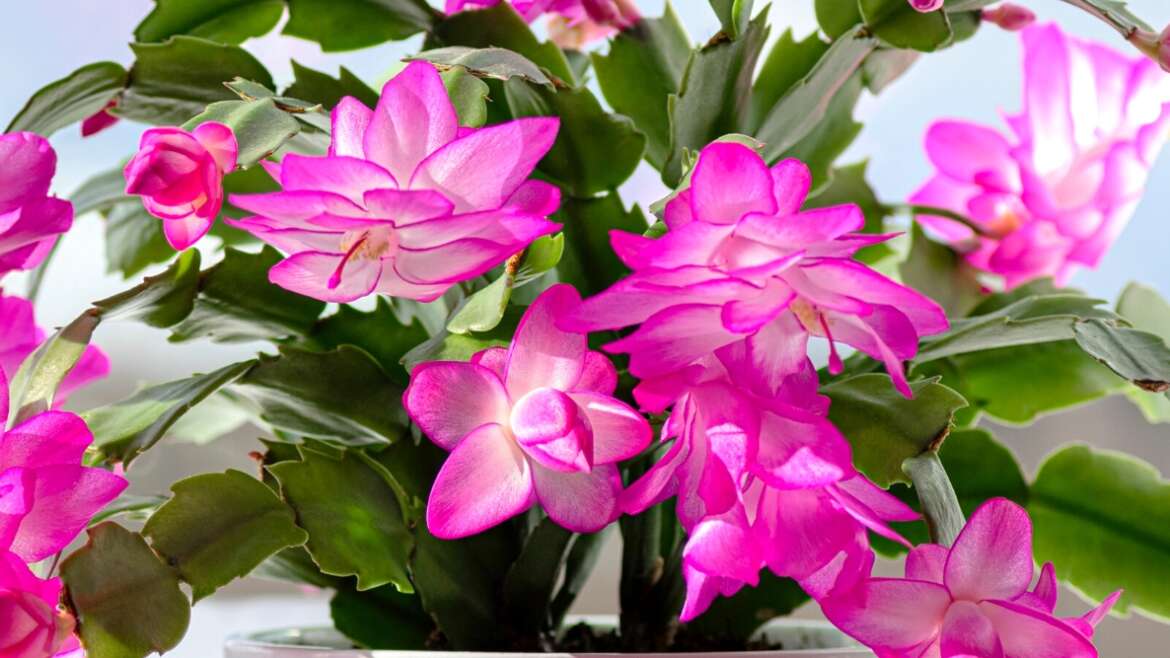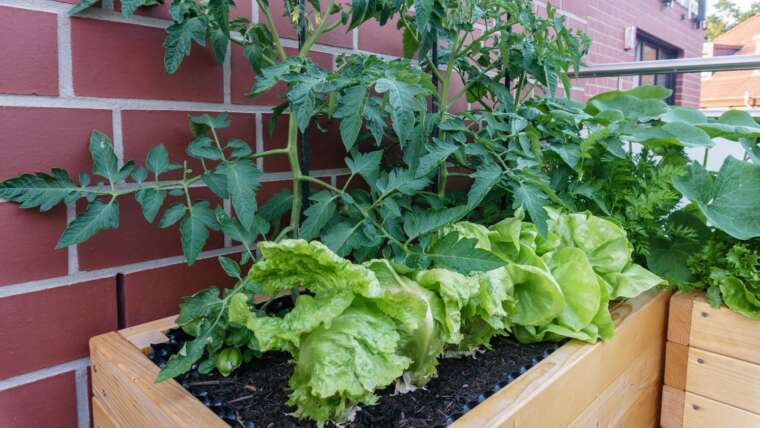Christmas cacti are very popular houseplants and lovely gifts for the holiday season. Towards the end of December, these succulent plants erupt in star-shaped, brightly colored flowers sprouting from the tips of emerald green leaf-covered stems. Over time, these plants can begin to look a bit off. Maybe they are discolored, or their leaves are dropping or wilting. While a few common diseases can affect Christmas cactus, the good news is that they are common with most houseplants and typically are related to growing conditions.
When it comes to Christmas cacti and most houseplants, preventing their diseases is much easier than treating them afterward. Following along with basic care guidelines will help you along this path.
In this article, I will briefly review which diseases are most common in these beautiful houseplants and how to prevent and treat them.
Overview
Christmas cacti are succulents that thrive in warmth, indirect light, and well-drained soil.
These beautiful plants are succulents, and as with the rest of the succulent bunch, they need warmth, light, and good drainage.
- Place your cactus in bright but indirect light for most of the season. However, during their dormant stage, they can use a bit more shade. If you are growing your plant outdoors, keep it out of direct sunlight during dormancy.
- Watering can be a tricky balance that all depends on where your plant is located and what your home is like. This succulent needs some humidity and likes to have its soil moist most of the time. While Christmas cacti can tolerate periods of dryness, it is intolerant of oversaturated soil. This is where diseases run rampant. If the air in your home is dry, use a humidifier or pebble tray to add humidity to your plants.
- The ideal temperature range is anywhere from 60–70 degrees Fahrenheit. Some chilly fall air is necessary to produce flowers. Moving your pot near a drafty window can help with this.
- Fertilize with a balanced general houseplant fertilizer in the fall. Apply according to the package instructions. Christmas cacti also benefit from some additional magnesium. Magnesium can help with overall plant health as well as the production of brightly colored foliage and flowers.
Botrytis Blight
 This disease thrives in moist soil and decaying foliage.
This disease thrives in moist soil and decaying foliage.
This fungal disease, also called grey mold, can affect any ornamental plant. The fungus that causes this disease loves to feed on soil moisture and any decaying foliage that may still be on the plant. It can also be found resting on the surface of the soil.
This disease is most common after rain or in areas of high humidity. You may first notice botrytis blight symptoms on older leaves and flowers.
This is an easy one to identify. If your stems, buds, or flowers appear grey and fuzzy you likely have botrytis blight on your hands. This grey fuzz may also be visible on the surface of the soil as well.
High humidity is a prime condition for botrytis blight. This can be tricky since the Christmas cactus does like some humidity.
- Keep your plants cleaned: remove fallen flowers or leaves and trim any stems that look unwell. This will help to keep airflow moving throughout the plant.
- Give your plants some space. Houseplants may look lovely when clustered together, but if you have a lot of humidity in your home, giving plants space will do them well.
- When you are watering, be gentle. Try not to get any water on the leaves or cause any splashing. The splashing of the spores with water will cause them to spread more rapidly on your cactus.
Treatment of botrytis blight is very similar to prevention:
- Begin by attempting to improve air quality and airflow around the plant. This could mean moving the plant away from other plants or giving it a little bit of a trim.
- Remove all infected plant tissues and throw them away. Burn them if possible
- Sanitize your clippers or any other tools that you have used in the process. This could include any scissors, snips, watering can, etc.
- In serious cases, purchase a copper fungicide and spray according to the labeled instructions.
Stem Rot
 Christmas cacti can suffer from stem rot, visible as brown spots on stems and leaves.
Christmas cacti can suffer from stem rot, visible as brown spots on stems and leaves.
Also known as basal stem rot, this disease will appear on plants living in wet soil in a cool environment. Stem rot is produced by two different fungi: fusarium and phytophthora.
If stem rot is advanced, you may be better off starting with a new plant. If a few healthy stems remain, you can propagate a new plant or two.
At the soil line, you will see a brown spot or line along the stems of your Christmas cactus. As the disease progresses, the scar will turn tan, and plant tissue will begin to fall off of the plant going straight through to the center of the plant.
Aside from the trademark brown spot, you may notice yellowing and wilting of the plant’s leaves. Another common sign of stem rot is brown spots on the leaves that appear as watermarks.
Do not overwater this plant. You can apply fungicide in a preventative manner to keep this disease from appearing on your plants.
If you are unsure how much you need to water, just keep an eye on the soil. These plants do best when the soil is moist most of the time, but if they are overwatered, they will suffer. It is okay to allow your soil to dry out slightly in between waterings.
Treat with a fungicide such as fungonil or copper fungicide. Hold off on watering until the soil has dried out.
If your plant is large, you can attempt to cut away the damaged tissue while leaving as much of the healthy plant behind as you can. Don’t forget to save a few healthy cuttings to propagate.
Necrotic Spot Virus
 Transmitted by thrips, necrotic spot virus is usually fatal once symptoms manifest.
Transmitted by thrips, necrotic spot virus is usually fatal once symptoms manifest.
Also known as impatiens necrotic spot virus, this disease is a force to be reckoned with. Transmitted primarily by thrips, it is often impossible to save your plant once it shows signs of this disease.
These insects have sucking mouthparts, and while feasting on plant tissues, they will transmit the disease from plant to plant.
Plants infected with necrotic spot virus will have yellow leaves, as well as wilted stems and wilted leaves.
Keep your eyes peeled for signs of thrips. This disease is spread by these pesky pests.
- Place sticky traps in your pot to monitor for the presence of thrips
- Use neem or insecticidal soap to treat any thrip infestation
Necrotic spot virus is tough to treat. If you have gotten rid of any thrips that were present and are still left with a sick plant, you can begin by isolating the plant from your other houseplants. Next, remove all the soil from your plant’s roots and any infested plant tissue. Repot in fresh potting soil and a clean, disinfected pot.
Place all infected plant tissue, as well as any potting soil, in one trash bag and dispose of it. Clean all tools that you have used during this process once you are finished by bleaching or using disinfectant wipes.
Root Rot
 The blackening of the root system is a hidden but critical symptom of root rot and can lead to wilting.
The blackening of the root system is a hidden but critical symptom of root rot and can lead to wilting.
Two types of root rot can affect Christmas cacti: phytophthora and pythium. Pythium root rot is more prevalent in potted plants such as houseplants. This type of root rot will attack new root tips, sometimes spreading to entire root systems.
If your potting soil is excessively wet and cannot dry out, your plant will suffer further symptoms and be difficult to revive.
The most common symptom is also the most difficult to see, which is the blackening of the root system. Sometimes, large sections of the root systems can rot completely. When this happens, you begin to see symptoms above ground.
You may notice the plant wilting, producing stunted growth and even plant death.
Root rot tends to be easier to prevent than it is to treat. Here are a few ways you can prevent this disease:
- Get yourself on a good watering schedule. Water just once every 1-2 weeks.
- Do not water if the soil is wet.
- Plant in a container with drainage holes.
If it is too late for prevention, treatment for root rot is possible. Here are a few tips:
- Remove your plant from its pot and trim away any rotted roots. Use caution, and don’t forget to sterilize your shears after you are finished.
- Repot in a disinfected container with fresh succulent potting soil.
- Once this is done, begin prevention methods! Hold off on fertilizing to allow the plant to acclimate to its new home.
- Alternatively, a fungicide such as propiconazole can help to treat root rot.
Powdery Mildew
 This disease may not be severely damaging, but it can look unsightly.
This disease may not be severely damaging, but it can look unsightly.
If you are an outdoor gardener with shady areas in your garden, you are likely very familiar with powdery mildew. Powdery mildew affects garden plants and is very common with succulents.
The good news about this disease is that it will not do much damage to the overall health of your plant. The bad news is that it can cause your plant to appear unattractive.
Powdery mildew is possibly one of the easiest diseases to identify. Your plant will look like someone threw flour at it. All parts of the cactus as well as the soil, can be covered in white or grey mildew. You may also notice some rust-colored spots on your cacti’s leaves.
Powdery mildew thrives in humid, damp, and shady areas of your garden, according to the University of Rhode Island.
- Provide sufficient airflow in between plants and do your best to prevent any crowding of plants.
- Do not overwater. This will encourage not only powdery mildew but most of the aforementioned diseases as well.
- Make sure your plant is getting some sunlight. If your potted cactus is living outdoors, keep it out of direct sunlight. Just do not leave it in a dark corner, especially in the summer months when it is most humid.
As I mentioned, most of the time, this is not a fatal disease for your plant.
- Neem oil is a great chemical treatment for prevention or treatment after the fact.
- Copper fungicide is another broad-spectrum fungicide that is useful against powdery mildew.
Whichever treatment you choose, check the label for application rates and apply with caution.
Final Thoughts
If your Christmas cactus looks less than festive this season, remain calm and take some time to diagnose it properly. Diseases can pop up for several reasons, mostly because of watering or the climate they are living in. Sometimes, the plant you have purchased from your garden center could already have a disease breeding within its soil before you even bring it home. Take a closer look at the symptoms and how you have cared for your plant. You will likely be able to identify and treat your cactus with ease.




